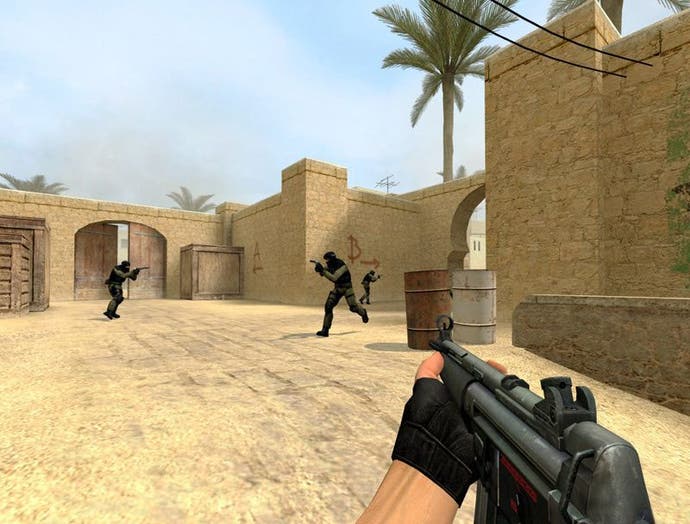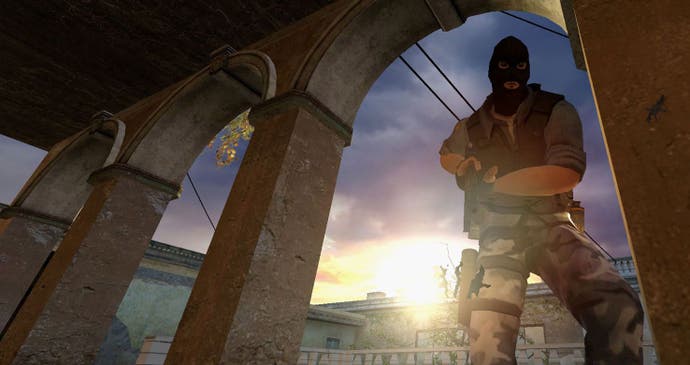Counter-Strike: Source
We spend a weekend with Valve's Source Engine-based Counter-Strike conversion, and really wish people would run with the knife...
Shop for games now with Simply Games.
It may be older than some of the younger people shopping for games on the high street these days, but even now Counter-Strike is the most popular online first-person shooter in existence. In fact, in terms of player and server numbers, it's about ten times as popular as its nearest competitor. It's a modern marvel. Having begun life with a pair of programmers working out of their bedrooms, its transformation is equivalent to something like Championship Manager, which saw the Collyer brothers elevated from deskbound Evertonians to kings of the simulation genre worldwide.
Conditioning

The secret to the game's success is something that virtually every other FPS developer since has had a lot of difficulty pinpointing - or even emulating. But in the end it's a question of balance. There is so much refinement in the current version of CS that when the Terrorists and Counter-Terrorists come crashing together at various 'choke points', it's a matter of skill and tactics that dictates the outcome, and not simply a question of which class is better than another. There are, in fact, no classes at all - players spawn as a team at opposite ends of a map, use a few seconds before the round begins to buy any weapons (a big one and a sidearm), ammunition and equipment they can afford using a series of 'buy menus', then charge off as a team. When a player dies, he sits out the rest of the round, watching using a chase camera.
Objectives are simple - plant the bomb, rescue the hostages - and each map can be tackled in a variety of ways. And, crucially, despite several years of tackling the same maps over and over, the outcome is never black and white, and there's always a lot of skill and sometimes - if you've ever chucked a grenade down a stairwell at a team-mate under the delusional misconception that he's an enemy; or done most of the hard part of flanking an enemy only to jump off a ledge and lose the rest of your health as you land - a fair amount of comedy. We still continue to play it.
Nevertheless, time has not been kind to Counter-Strike. It's still as sharp as ever to play - a perfectly poised, objective-based team game that demands tactics and twitch-killing skill to succeed - but graphically it's incredibly ropey when placed alongside just about anything else on the market today. It's certainly about time it had a makeover - something neither the Xbox version nor the unfairly maligned Condition Zero bothered to tackle to any great extent. Counter-Strike: Source, unveiled at E3 this year, is exactly what's required - the game we all remember and continue to love (and scream at) on a nightly basis, made over using Half-Life 2's ridiculously powerful Source Engine.
Saucy Number

Interestingly though, bringing the game up to scratch in terms of visuals wasn't Valve Software's primary motivation in developing CS: Source. According to marketing man Doug Lombardi, the idea originally came to life when the developer began investigating how difficult it was to port Half-Life 1 mods to the Source Engine - something that the game's vast community of fans would obviously have to worry about once Half-Life 2 shipped.
After a few people ported single-player Half-Life to Source, Valve then decided to try it out on one of its own projects - and Counter-Strike was the obvious choice. Not long after that the team had new player, weapon and world models, sound effects, a new interface, and Havok-based physics that had the potential to bring a whole new dimension to the game. Imagine Counter-Strike with a much more physical world, where grenades shower barrels over people rushing up the stairs on de_aztec, and makeshift barricades are just a few well placed kicks away.
Having wowed us with a trailer at E3 though, which saw a dramatically improved Aztec up and running with feet and bullets kicking up water as they splashed their way under the bridge, gorgeous reflections and some evidence of the impact of HL2's physics engine, it's been rather quiet on the CS Source front for some time now. But not any more. With Half-Life 2 potentially just weeks away, Valve has started giving Cyber Café owners and - soon - Condition Zero and ATI coupon holders the chance to tackle a beta version, featuring all the graphical, audio and physical enhancements we'd been promised on one of the game's most enduring maps - de_dust.
Desert Island Discs

Dust is certainly an interesting choice of map to lead out with. Whilst undoubtedly one of the game's most popular, it's also one of the least exciting, visually. In maps like Aztec and Italy, Valve had the chance to showcase some of the engine's most gorgeous effects (the reflection and reaction of the water, cobble-stoned streets and packed wine cellars, and so on), next to which Dust's rather monochrome sandstorm was always going to suffer in comparison. However, the results are still fairly impressive. Valve has doubled the texture resolution, which instantly gives the whole thing a much sharper look, and DirectX features like bump-mapping and specularity give those textures depth - and, indoors at the traditional choke point where both teams generally collide, there's an oddly reflective stone floor to admire as you fiddle with the silencer on the end of your Colt.
The world's a lot more lively and less predictable, too. Death animations are more believable, and there are barrels, tyres and static objects strewn around to breathe some more life into the world - some of which, most notably the barrels, can be knocked around a fair bit at the behest of grenades and gunfire. Watching sparks fly off the barrels in wonderment has cost more than a handful of our team-mates a good few rounds of precious ammunition, but despite the extra cost at the next respawn, they don't seem to mind. And, although we wouldn't recommend it with snipers around, there was some evidence of the makeshift barricades Lombardi mentioned - at one point, barrels soaked up bullets aimed for our legs as we scampered through the double doors towards one of the bombsites.
You can't blow shards out of the wood like you'll be able to in Half-Life 2, it seems (which puts pay to our falling rope bridge/Aztec fantasies in one go), but there are some subtle and not-so-subtle effects we did enjoy - the new flashbang effect, which turns the screen white then brings everything slowly back into focus like a recalibrating monitor, in particular, and the way Terrorists now tap numbers into a keypad when planting the bomb instead of just watching a progress bar. The new weapon models and reload animations are nice too, although Counter-Strike's efforts in this area were always a lot further ahead than the rest of the game anyway, so it's not quite the quantum leap some might expect.
Who threw that Flashbang?

The most important question though is how the game plays now it's been transplanted into a new engine. Fortunately, Valve's stuck to its word in this area - keeping the experience intact for now, with the possibility of new features something to be explored further down the line. For now then, all the weapons and items currently in CS have been included, and any alterations are subtle and generally benign. The movement speed of the camera when you die, for example, is a bit quicker now, but that can only be a good thing, and most of the other changes concern the integration of barrels and other physical objects, which don't have a massive impact.
In terms of map-specific changes, there are a few things to note, although we're not sure if they're deliberate or just side effects of expanding each map's skybox and converting things. For example, there are now a couple of cheeky sniping spots that we don't remember - it's possible to climb up behind the CT spawn and lurk there, menacingly, and using the crates opposite the double doors it's possible to clamber up above the choke point and pick people off as they come out of the doors or up the ramp from under the bridge. It's not necessarily any more advantageous - in fact it makes you a bit of a sitting duck at times - but we didn't even think to look there at first, which put pay to our terrible aspirations on a couple of occasions.
Still, given the problems that the developer has had in the past with balancing issues in certain builds of the Half-Life mod, the CS: Source beta ought to be viewed as a success. It wasn't broken, so Valve hasn't fixed it; what the team has done instead is recreate one of the best multiplayer FPS games ever conceived using technology that does it justice, right down to voice communications and radio binds. It's not going to amaze anybody currently toiling through Doom III on high-end kit, nor is it on a par with what we've seen of Half-Life 2, but for a game that has to cope with up to 32 players at a time, it's a suitably impressive level of detail, and - significantly - it isn't so much detail that you'll have difficulty picking enemies out from the horizon. Furthermore, it runs extremely well on our test machines, even at relatively high resolution. Playing it on this writer's P4 2.8GHz, Radeon 9700 Pro system loaded with 1GB RAM, 1280x1024 resolution is smoother than a silk ski mask.
Striking
None of that's to say Valve won't make changes in the future, of course, but for now CS: Source is a solid and instantly recognisable foundation. Although we're limited to Dust for now, we look forward to seeing Chateau, Dust II, Havana, Italy, Office, Piranesi and of course Aztec in their newfound glory in the near future - and Valve is promising more of the classic line-up thereafter. And with the game set to be bundled with Half-Life 2 and made available as a standalone purchase (and followed by Source versions of TFC, Day of Defeat and others), it ought to quickly build up a similarly massive following. It's not Counter-Strike 2, then, but we can't imagine there are many fans that won't want to play it.
The Counter-Strike: Source beta is running at the various Cyber Cafés listed here right now, and should be made available to Condition Zero owners later in the week. The full version will ship alongside Half-Life 2, which is reportedly on track for release in September.

